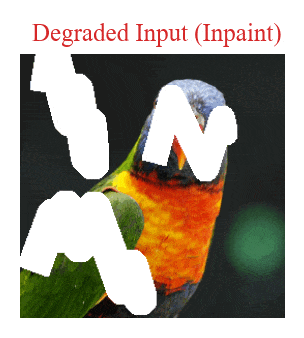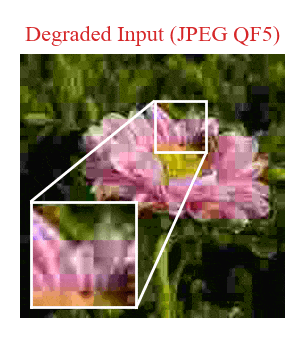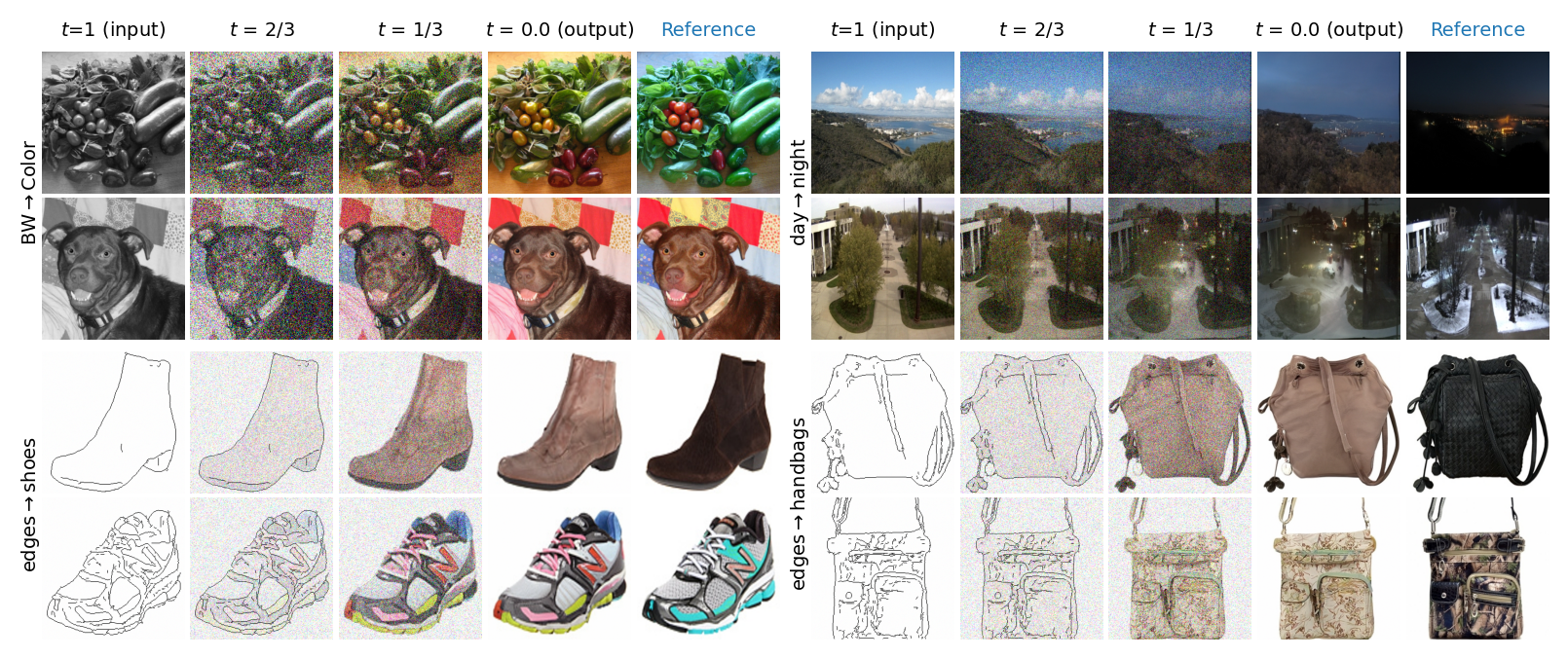Weili Nie2,† · Anima Anandkumar2,3,†
1Georgia Tech 2NVIDIA Corporation 3Caltech †equal advising
[project page] [arXiv]
Official PyTorch implementation of I2SB, a new class of conditional diffusion models that directly construct diffusion bridges between two given distributions. I2SB yields interpretable generation, enjoys better sampling efficiency, and sets new records on many image restoration tasks.
In additinoal to image restoration tasks, I2SB can also be applied to general image-to-image translation such as pix2pix. For more general tasks, we recommand adding the flag --cond-x1 to the training options to overcome the large information loss in the new priors.
Visualization of the generation processes of I2SB are shown below.
This code is developed with Python3, and we recommend PyTorch >=1.11. Install the dependencies with Anaconda and activate the environment i2sb with
conda env create --file requirements.yaml python=3
conda activate i2sbAll checkpoints are trained with 2 nodes, each with 8 32GB V100 GPUs. Pre-trained checkpoints and can be downloaded from here or via
bash scripts/download_checkpoint.sh $NAMEwhere NAME can be one of the following image restoration tasks
jpeg-5: JPEG restoration with quality factor 5jpeg-10: JPEG restoration with quality factor 10sr4x-pool: 4x Super-resolution with pooling filtersr4x-bicubic: 4x Super-resolution with bicubic filterblur-uni: Deblurring with uniform kernelblur-gauss: Deblurring with Gaussian kernelinpaint-center: Inpainting with 128x128 center maskinpaint-freeform1020: Inpainting with 10-20% freeform maskinpaint-freeform2030: Inpainting with 20-30% freeform mask
Checkpoints will be stored in results/$NAME. After downloaded, you can run the sampling and evaluation with the provided command lines.
To sample from some checkpoint $NAME saved under results/$NAME, run
python sample.py --ckpt $NAME --n-gpu-per-node $N_GPU \
--dataset-dir $DATA_DIR --batch-size $BATCH --use-fp16 \
[--nfe $NFE] [--clip-denoise]where N_GPU is the number of GPUs on the node and DATA_DIR is the path to the LMDB dataset. By default, we use --use-fp16 for faster sampling. The number of function evaluations (NFE) determines sampling steps and, if unspecified, is set as in training. In practice, I2SB is insensitive to --clip-denoise, which clamps the predicted clean images to [-1,1] at each sampling step.
The reconstruction images will be saved under results/$NAME/samples_nfe$NFE/. By default, we use the full validation set for 4x super-resolution tasks and the 10k subset suggested by Palette for the rest of the restoration tasks.
(Optional) To parallelize the sampling across multiple nodes, add --partition 0_4 so that the dataset is partitioned into 4 subsets (indices 0,1,2,3) and only run the first partition, i.e. index 0. Similarly, --partition 1_4 run the second partition, and so on.
To evaluate the reconstruction images saved under results/$NAME/$SAMPLE_DIR/, run
python compute_metrices.py --ckpt $NAME --dataset-dir $DATA_DIR --sample-dir $SAMPLE_DIRto compute the accuracy on ResNet-50 and FID. The FID computation is based on clean-fid package with mode="legacy_pytorch".
Regarding the FID reference statistics, we follow Palette and ΠGDM and use the full training set for 4x super-resolution tasks and the full validation set for the rest of the restoration tasks. The statistics of training set will be automatically downloaded from ADM, and the statistics of validation set will be computed and saved to data/fid_imagenet_256_val.npz at first call.
We train and evaluate I2SB on ImageNet 256x256 with the LMDB format; hence, you may need to convert the image folder to LMDB. Use the flag --dataset-dir $DATA_DIR to specify the dataset directory. Images should be normalized to [-1,1]. External data (e.g., ADM checkpoints, FID ref statistics) will be automatically downloaded and stored in data/ at first call. All training and sampling results will be stored in results. The overall file structures are:
$DATA_DIR/ # dataset directory
├── train_faster_imagefolder.lmdb # train images in LMDB format
├── train_faster_imagefolder.lmdb.pt # train ImageFolder with (path,label) list
├── val_faster_imagefolder.lmdb # val images in LMDB format
└── val_faster_imagefolder.lmdb.pt # val ImageFolder with (path,label) list
data/ # auto-downloaded files:
└── ... # ADM checkpoints, FID ref stats, freeform masks, etc.
results/
├── $NAME/ # experiment ID set in train.py --name $NAME
│ ├── latest.pt # latest checkpoint: network, ema, optimizer
│ └── options.pkl # full training options
│ └── samples_nfe$NFE/ # images reconstructed from sample.py --nfe $NFE
│ └── recon.pt
├── ...To train an I2SB on a single node, run
python train.py --name $NAME --n-gpu-per-node $N_GPU \
--corrupt $CORRUPT --dataset-dir $DATA_DIR \
--batch-size $BATCH --microbatch $MICRO_BATCH [--ot-ode] \
--beta-max $BMAX --log-dir $LOG_DIR [--log-writer $LOGGER]where NAME is the experiment ID (default: CORRUPT), N_GPU is the number of GPUs on each node, DATA_DIR is the path to the LMDB dataset, BMAX determines the noise scheduling. The default training on 32GB V100 GPU uses BATCH=256 and MICRO_BATCH=2. If your GPUs have less than 32GB, consider lowering MICRO_BATCH or using samller network. CORRUPT can be one of the following restoration tasks:
- JPEG restoration: quality factor 5 or 10 (
jpeg-5,jpeg-10) - 4x Super-resolution: pool or bicubic filter (
sr4x-pool,sr4x-bicubic) - deblurring: uniform or Gaussian kernel (
blur-uni,blur-gauss) - 128x128 center-masked inpainting (
inpaint-center) - freeform inpainting: masked ratio 10-20% or 20-30% (
inpaint-freeform1020,inpaint-freeform2030)
Add --ot-ode for optionally training an OT-ODE model, i.e., the limit when the diffusion vanishes. By defualt, the model is discretized into 1000 steps; you can change it by adding --interval $INTERVAL.
Note that we initialize the network with ADM (256x256_diffusion_uncond.pt), which will be automatically downloaded to data/ at first call.
Images and losses can be logged with either tensorboard (LOGGER="tensorboard") or W&B (LOGGER="wandb") in the directory LOG_DIR. To autonamtically login W&B, specify additionally the flags --wandb-api-key $WANDB_API_KEY --wandb-user $WANDB_USER where WANDB_API_KEY is the unique API key (about 40 characters) of your account and WANDB_USER is your user name.
To resume previous training from the checkpoint, add the flag --ckpt $CKPT.
See scripts/train.sh for the hyper-parameters of each restoration task.
For multi-node training, we recommand the MPI backend.
mpirun --allow-run-as-root -np $ARRAY_SIZE -npernode 1 bash -c \
'python train.py $TRAIN \
--num-proc-node $ARRAY_SIZE \
--node-rank $NODE_RANK \
--master-address $IP_ADDR 'where TRAIN wraps all the the original (single-node) training options, ARRAY_SIZE is the number of nodes, NODE_RANK is the index of each node among all the nodes that are running the job, and IP_ADDR is the IP address of the machine that will host the process with rank 0 during training; see here.
@article{liu2023i2sb,
title={I{$^2$}SB: Image-to-Image Schr{\"o}dinger Bridge},
author={Liu, Guan-Horng and Vahdat, Arash and Huang, De-An and Theodorou, Evangelos A and Nie, Weili and Anandkumar, Anima},
journal={arXiv preprint arXiv:2302.05872},
year={2023},
}
Copyright © 2023, NVIDIA Corporation. All rights reserved.
This work is made available under the Nvidia Source Code License-NC.
The model checkpoints are shared under CC-BY-NC-SA-4.0. If you remix, transform, or build upon the material, you must distribute your contributions under the same license as the original.
For business inquiries, please visit our website and submit the form: NVIDIA Research Licensing.



